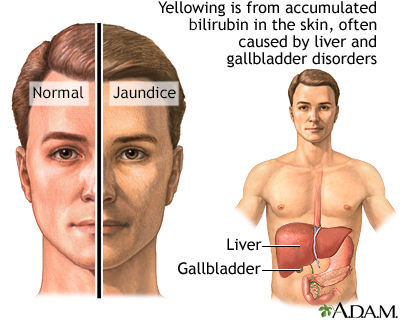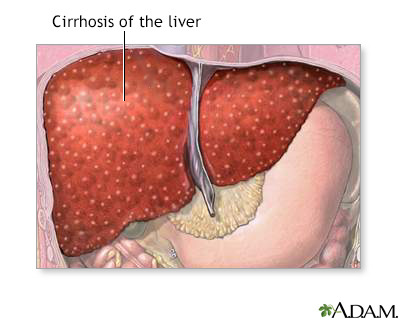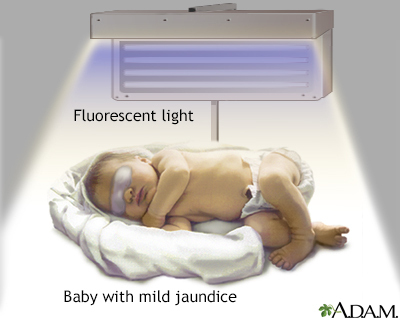Definition
Jaundice is a yellow color of the skin, mucus membranes, or eyes. The yellow coloring comes from bilirubin, a byproduct of old red blood cells. Jaundice can be a symptom of several health problems.
Alternative Names
Conditions associated with jaundice; Yellow skin and eyes; Skin - yellow; Icterus; Eyes - yellow; Yellow jaundice
Causes
A small number of red blood cells in your body die each day, and are replaced by new ones. The liver removes the old blood cells. This creates bilirubin. The liver helps break down bilirubin so that it can be removed by the body through the stool.
Jaundice can occur when too much bilirubin builds up in the body.
Jaundice can occur if:
- Too many red blood cells are dying or breaking down and going to the liver.
- The liver is overloaded or damaged.
- The bilirubin from the liver is unable to properly move into the digestive tract.
Jaundice is often a sign of a problem with the liver, gallbladder, or pancreas. Things that can cause jaundice include:
- Infections, most commonly viral
- Use of certain drugs
- Cancer of the liver, bile ducts or pancreas
- Blood disorders, gallstones, birth defects and a number of other medical conditions
Symptoms
Jaundice may appear suddenly or develop slowly over time. Symptoms of jaundice commonly include:
- Yellow skin and the white part of the eyes (sclera) -- when jaundice is more severe, these areas may look brown
- Yellow color inside the mouth
- Dark or brown-colored urine
- Pale or clay-colored stools
- Itching (pruritis) usually occurs with jaundice
Note: If your skin is yellow and the whites of your eyes are not yellow, you may not have jaundice. Your skin can turn a yellow-to-orange color if you eat a lot of beta carotene, the orange pigment in carrots.
Other symptoms depend on the disorder causing the jaundice:
- Cancers may produce no symptoms, or there may be fatigue, weight loss, or other symptoms.
- Hepatitis may produce nausea, vomiting, fatigue, or other symptoms.
Exams and Tests
The health care provider will perform a physical exam. This may show liver swelling.
A bilirubin blood test will be done. Other tests may include:
Treatment
Treatment depends on the cause of the jaundice.
When to Contact a Medical Professional
Contact your provider if you develop jaundice.
References
Fargo MV, Grogan SP, Saquil A. Evaluation of jaundice in adults. Am Fam Physician. 2017;95(3):164-168. PMID: 28145671 pubmed.ncbi.nlm.nih.gov/28145671/.
Korenblat KM, Berk PD. Approach to the patient with jaundice or abnormal liver tests. In: Goldman L, Schafer AI, eds. Goldman-Cecil Medicine. 26th ed. Philadelphia, PA: Elsevier; 2020:chap 138.
Lidofsky SD. Jaundice. In: Feldman M, Friedman LS, Brandt LJ, eds. Sleisenger and Fordtran's Gastrointestinal and Liver Disease: Pathophysiology/Diagnosis/Management. 11th ed. Philadelphia, PA: Elsevier; 2021:chap 21.
Taylor TA, Wheatley MA. Jaundice. In: Walls RM, Hockberger RS, Gausche-Hill M, eds. Rosen's Emergency Medicine: Concepts and Clinical Practice. 9th ed. Philadelphia, PA: Elsevier; 2018:chap 25.





